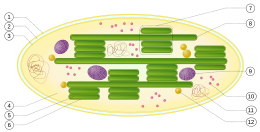
|

A chloroplast is a small organelle inside the cells of plants and algae. They absorb light to make sugar in a process called photosynthesis. The sugar can be stored in the form of starch.
Chloroplasts contain the molecule chlorophyll, which absorbs sunlight for photosynthesis. In addition to chlorophyll, a chloroplast uses carbon dioxide (CO2) and water (H2O) to form sugar and gives off oxygen (O2).